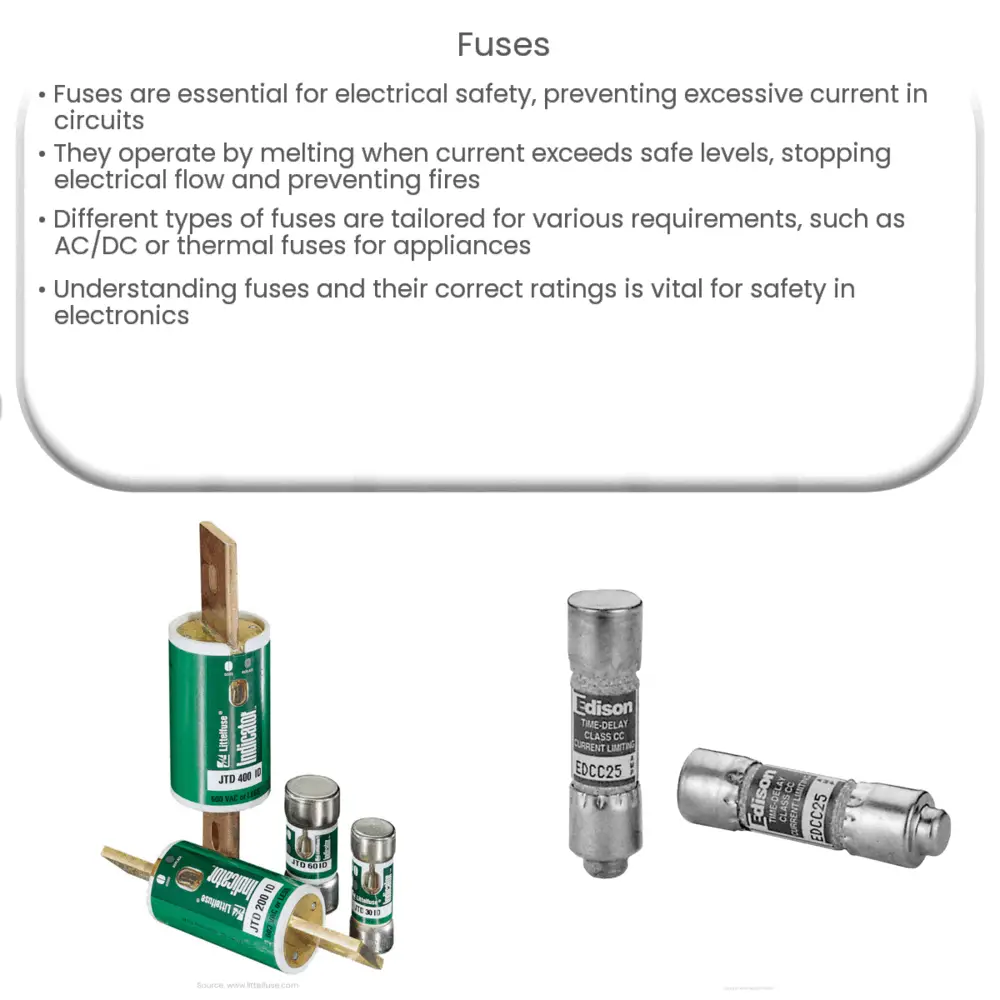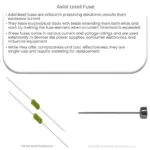Explore the importance of fuses in electrical safety, their working mechanism, types, applications, and comparison with circuit breakers.

Fuses: A Key Component in Electrical Safety
Designed as a fail-safe in the field of electronics, fuses are a crucial component in the overarching scheme of electrical safety. A fuse is essentially a sacrificial element that prevents excessive amounts of current from flowing through an electric circuit, thus protecting the underlying electrical devices from potential damage caused by overcurrent or a short circuit condition.
The Basic Principle Behind Fuses
The operating principle of a fuse is based on the electrical properties of the material used in the fuse wire or element. When a current exceeds the rated value that the fuse can safely handle, the increased electrical resistance causes the fuse wire to heat and melt, hence ‘blowing’ the fuse. This interrupts the flow of electric current and prevents the overheating of wires, a common cause of electrical fires.
Classification of Fuses
- AC Fuses: AC (Alternating Current) fuses are commonly found in residential and commercial buildings. They function by breaking the circuit when an overcurrent scenario is detected in an AC circuit.
- DC Fuses: DC (Direct Current) fuses are used primarily in automotive and electronics industries. They are designed specifically for circuits where the current flows in a single direction.
Different Types of Fuses
Fuses come in various types, each designed to meet specific requirements in different scenarios. Here are some of the most common types:
- Cartridge Fuse: Named after its cylindrical shape, this type is fully enclosed in an insulating material. The end caps serve as contacts, while the fuse link is located in the center.
- Blade Fuse: Mostly used in automobiles, a blade fuse uses flat ‘blades’ that fit into corresponding receptacles.
- Thermal Fuse: Commonly found in household appliances such as coffee makers and hair dryers, thermal fuses are designed to break the circuit if a dangerous temperature level is reached.
- Resettable Fuse: Also known as a PolySwitch or PTC (Positive Temperature Coefficient) thermistor, a resettable fuse returns to its original state once the overload condition is removed.
Overall, fuses play an integral role in electrical safety. Their ability to detect and mitigate overcurrent conditions has helped to prevent countless electrical accidents, thereby safeguarding both lives and property.
The Working Mechanism of Fuses
Fuses function on the principle of electrical heating. As a current passes through the fuse wire, heat is generated. For currents within the safe limit, this heat is harmlessly dissipated into the surrounding environment. However, when an excessive current flows through the fuse, the heat generated is too much to be effectively dissipated. Consequently, the temperature of the fuse wire rises until it reaches its melting point and breaks apart, thereby severing the electrical connection and disconnecting the electrical circuit.
Fuse Ratings
It’s important to understand that each fuse is designed to handle a specific amount of electrical current, referred to as its rating. When replacing a blown fuse, it is crucial to replace it with another fuse of the same rating. Installing a fuse with a higher rating can lead to overheating and potential fire, while a lower rating will cause the fuse to blow prematurely.
Fuse vs Circuit Breaker
While the fuse is a single-use device that needs to be replaced after each operation, a circuit breaker serves a similar purpose but can be reset and reused multiple times. Although more expensive, circuit breakers offer convenience and can handle higher current loads compared to fuses. Nonetheless, fuses continue to be used due to their reliability, simplicity, and cost-effectiveness.
Applications of Fuses
Fuses find applications in a myriad of industries, including automotive, aerospace, electronics, and more. They are instrumental in power systems, consumer electronics, automotive systems, and industrial machinery, among others. In our everyday lives, we encounter fuses in the electrical systems of our homes, in our cars, and in various household appliances.
Conclusion
In summary, fuses are a pivotal safety component in electrical systems, protecting circuits from the hazardous effects of overcurrent. Through their simple yet effective design, they help safeguard our electronics and, by extension, our homes and businesses from potential electrical fires. From the variety of types available to their applications in diverse industries, the humble fuse continues to be a silent protector in the vast field of electronics. Understanding their operation, types, and application helps us appreciate the importance of this simple yet vital component.




